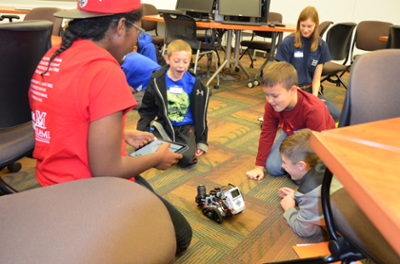Kode2Learn continues educating future computer scientists

[All photos were taken at an earlier date, pre-COVID-19]
During a typical semester, Kode2Learn members travel to six elementary schools in the surrounding area to teach coding lesson plans to second through fifth graders.
While they aren’t physically going to the schools this semester, the young students have no shortage of lesson plans, as Kode2Learn is rolling out an asynchronous, remote curriculum to keep everyone involved. 
Each week, one or two lesson plans will go out to the schools’ technology departments to be dispersed to students interested in the program, all the way up until the end of December.
Eventually, they hope to cut out the middleman and connect directly with the students remotely.
“If we can go back to the schools in person next semester, we’ll do that,” Joe Rutkowski, a junior software engineering major and president of Kode2Learn, said. “Otherwise, we’ll start up with more [virtual] lessons [in February].”
The assignments have two components: a scratch file — computer programming language designed for early education — where they do the main coding activities, and a video accompaniment, filmed by Kode2Learn members for instructional purposes.
“Something we’ve learned in the past is that not all of our students will have learned [certain topics] at this point,” Rutkowski said. “We teach a couple second graders and it’s not in their curriculum yet.”
To mitigate this and make activities accessible for all, students are given a fact sheet as a guide for more difficult topics.
While Kode2Learn’s current involvement is limited to elementary schools, they are in the very early stages of making a middle school curriculum, as well. That way students are able to continue to craft their skills at a higher level, even after grade five.
“A good chunk of a reason why I’m involved in this club...is because [I] did not have these experiences growing up,” Rutkowski said. “It’s important to get [this] out there for all the future computer scientists in the world.”
By Jenna Calderón, CEC Reporter

